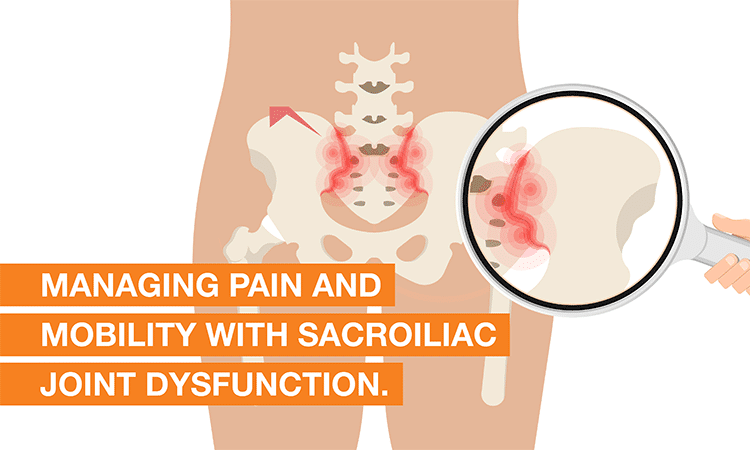Request Appointment
Enter your details and we will be in touch with you shortly;
Or call
8655885566
between 8 am and 8 pm.


Waking up with reduced mobility or pain in the lower back or hip region can be irritating. It is especially true if the pain is recurring, giving you nightmares. If the pain is localized to the lower back or hip region characterized by stiffness, reduced mobility, or pain when moving, twisting, or bending, it could be a sacroiliac joint dysfunction.
A proper diagnosis and treatment plan can help you escape clutches of recurring low back pain. Let us explore Sacroiliac Joint Dysfunction a bit more closely and how you can manage it through various tips and techniques available.
Anatomically, the spine begins at the base of the head, extends through the neck, upper and lower back, and culminates in the hip region, specifically at the junction of the sacrum bone and the ilium of the pelvis, forming a joint known as the ‘sacroiliac joint’ or SI joint. This joint, one of the largest in the body, serves as a shock absorber, distributing weight across the pelvis whenever you move.
Structurally, the SI joint is irregularly shaped and fits together like a puzzle. Like any other joint, it is surrounded by connective tissues and muscles that work in tandem with other tissues to facilitate movement and stability. It is the joint that comes into play whenever you engage in actions such as moving, bending, twisting, turning, or any other physical activity. The space within this joint is filled with synovial fluid, which acts as a lubricant, and it also contains nerve endings responsible for transmitting pain signals to the brain.
While your SI joints have limited mobility, they can move slightly to facilitate motion. However, in cases of SI joint dysfunction, this joint loses its ability to move as intended. This not only restricts mobility but also leads to pain and inflammation. Arthritis in the SI joints can exacerbate inflammation due to cartilage wear and the development of bone spurs, which can rub against each other.
Researchers have identified several causes contributing to SI joint dysfunction. For instance, osteoarthritis due to aging causes the cartilage between SI joints to wear down. Ankylosing spondylitis is an inflammatory type of arthritis that causes bone growth and fusion particularly in the spine joints.
Gout is another condition linked to high levels of uric acid followed by joint pain and can be potentially severe. Improper walking posture could cause SI joint dysfunction too. Additionally, injuries or pregnancy could cause pain in the SI joints as well.
The symptoms of a dysfunctional SI joint disorder may be difficult to distinguish from other types of back pain. People usually complain about localized pain in their buttocks, which can range from stabbing and sharp sensations to a shooting pain that extends downward, affecting the posterior thigh down to the knee. Those affected with an SI joint disorder might find it painful to climb stairs, sit down, or lie down on the same side as the pain.
Patients may also experience tenderness in their joints or stiffness in the lower back or hip area, which can make everyday tasks such as bending or twisting more challenging. Another symptom is difficulty sitting for extended periods or bending forward, as it places strain on the mechanical functionality of the joint.
If you are experiencing chronic lower back or hip pain, your doctor may recommend a series of tests to help diagnose the issue. The first step is a physical examination, during which the doctor will assess your posture, gait, and symptoms, examine the hip and lower back region, review your medical history and comorbidities, and evaluate rotational movements to assess the SI joint and its mobility.
Imaging tests, such as X-rays, CT scans, and MRIs, can aid in the diagnosis too. They can reveal abnormalities in the sacroiliac joint, rule out any other underlying conditions, and enable the development of customized treatment plans for you.
There are plenty of methods available which can treat SI joint dysfunction, and each has pros and cons.
Physical therapy has proven to be a crucial component in managing pain and mobility issues associated with SI joint dysfunction. A healthcare professional can create a targeted treatment program focused on strengthening muscles and improving mobility and flexibility. Moreover, since physical therapy is non-invasive, it is a favorable option to consider.
Pain in the lower back and hip region can be irritating especially if it’s constant or recurring. Perhaps, certain medications can help relieve inflammation. As these medications may carry gastrointestinal and other side effects, it’s recommended to consult a doctor before making any decisions.
Your doctor can create a tailored treatment plan based on your medical history, current condition, symptoms, and other peculiarities to help alleviate the pain.
SI joint dysfunction can be painful and inflammatory, limiting your mobility and making it difficult to perform daily tasks, especially in severe cases. The methods mentioned above are just a few of the available options that can effectively address SI joint dysfunction to varying degrees.
Need assistance in finding the best treatment plan for your condition? QI Spine has successfully helped thousands of patients regain control of their lives by addressing spine-related issues. Contact us at 086558 85566 to schedule your first free consultation.
Visit our nearest clinic for your first consultation